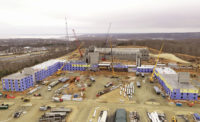Although construction industry officials still await the full details of President Trump’s infrastructure investment package, there has been a steady flow of funding for roads, bridges and other transportation projects in the MidAtlantic area.
The federal gasoline tax hasn’t been increased since 1993, but Maryland, Pennsylvania, Virginia and the District of Columbia all enacted gas tax hikes in 2013 that are fueling current state and local projects. West Virginia is considering its own gas tax increase as funds dedicated for road repairs have dropped $53 million in the last four years. The state Senate recently proposed an increase to the sales tax to 7.25%, which, if enacted, would match California’s as the nation’s highest.
ENR Mid-Atlantic 2017 Top Design Firms
Some officials are calling for a regional sales tax to bolster the Washington Metropolitan Area Transit Authority. “We’ve seen tremendous progress on states being leaders,” says Atkins North America CEO George Nash. “It’s a very exciting time from that standpoint.”
The 2017 ENR MidAtlantic Design Firm survey shows what Nash calls a “buoyant” infrastructure sector. The 107 participating firms reported a combined $1.6 billion in transportation work and $1.4 billion in civil engineering revenue. Sectors such as government and public services ($292.9 million in revenue), sewage and solid waste ($267.8 million), water supply ($245.6 million), power ($210.1 million) and telecommunications ($52.7 million) remain healthy, too.
Overall, the 107 participating firms reported a total of $4.8 billion in work performed and billed in 2016. That’s an 18.8% increase from last year’s survey, when 83 firms posted $4.04 billion in 2015 revenue. The top 10 firms amassed $2.8 billion in regional revenue this year. All but one top 10 firm increased its revenue from 2015.
Transportation Improvements
The transportation sector remains the region’s busiest. More than 30 firms on this year’s survey ranked transportation as a top revenue producer, including No. 25-ranked Clark Nexsen. The firm is working on the $120-million Lesner Bridge Replacement in Virginia Beach. The project’s first phase is scheduled to be completed in 2018.
Atkins—the lead designer for the $5.6-billion Purple Line, planned for Washington, D.C.’s Maryland suburbs—jumped to No. 15 this year from 38 last year as its revenue more than tripled, to $85.6 million. No. 13-ranked Mott MacDonald is responsible for underground design on the Purple Line. The firm, with 23% of its work coming in the transportation sector, is the lead designer for the Parallel Thimble Shoal Tunnel in the Chesapeake Bay. It will create a new bored tunnel between two artificial portal islands, providing an easier crossing for motorists.
No. 1-ranked AECOM reported that transportation accounted for 35% of its $655.7 million in regional revenue, up from $640.9 million in 2015. AECOM was recently selected as the lead engineering firm for a $336-million project to extend express lanes on Interstate 395 in Virginia. Design work for the eight-mile extension began in February; construction will begin this summer.
Daniel Faust, a regional executive at AECOM, credits the 2015 Fixing America’s Surface Transportation Act for boosting transportation projects. He says successful legislation supporting public-private partnerships in every MidAtlantic state is important for supporting major projects such as the Hampton Roads Bridge Tunnel in Virginia. The Virginia Dept. of Transportation recently released a request for information for the $3.3-billion project, which would widen one of the most congested tunnels in the region. Construction is expected to begin in 2019.
Water Fight
Fifteen firms ranked water supply as a top revenue source on this year’s survey.
AECOM has provided services to DC Water’s Blue Plains Advanced Wastewater Treatment Plant since the 1930s and is currently the construction and program manager for integrated upgrades and expansion for the 384-million-gallon-per-day facility.
Faust also says that the “Chesapeake Bay watershed and demand for clean water are driving growth across the region,” although Trump’s proposed fiscal 2018 budget would eliminate the $73-million program to clean up the bay.
Trump’s budget also would slash the Army Corps of Engineers civil works program by 16%, to about $5 billion. Atkins’ success in the MidAtlantic region depends heavily on contracts from the Corps and other government agencies. “We’re still a long way away from an approved [federal 2018] budget,” Nash says. “However, from what I’ve seen so far, it could impact some areas of our business while others could benefit. In aggregate, I don’t believe the overall business will be greatly affected.”









